Clematis Princess Diana - variety description
Due to its unusual external data, Clematis Princess Diana (Princess Diana) is the favorite variety of millions of gardeners from different countries. It was bred in Britain through a long selection of Texas Clematis. In 1984, Peveril Clematis Nursery registered a new hybrid, named after the beloved Lady Dee.
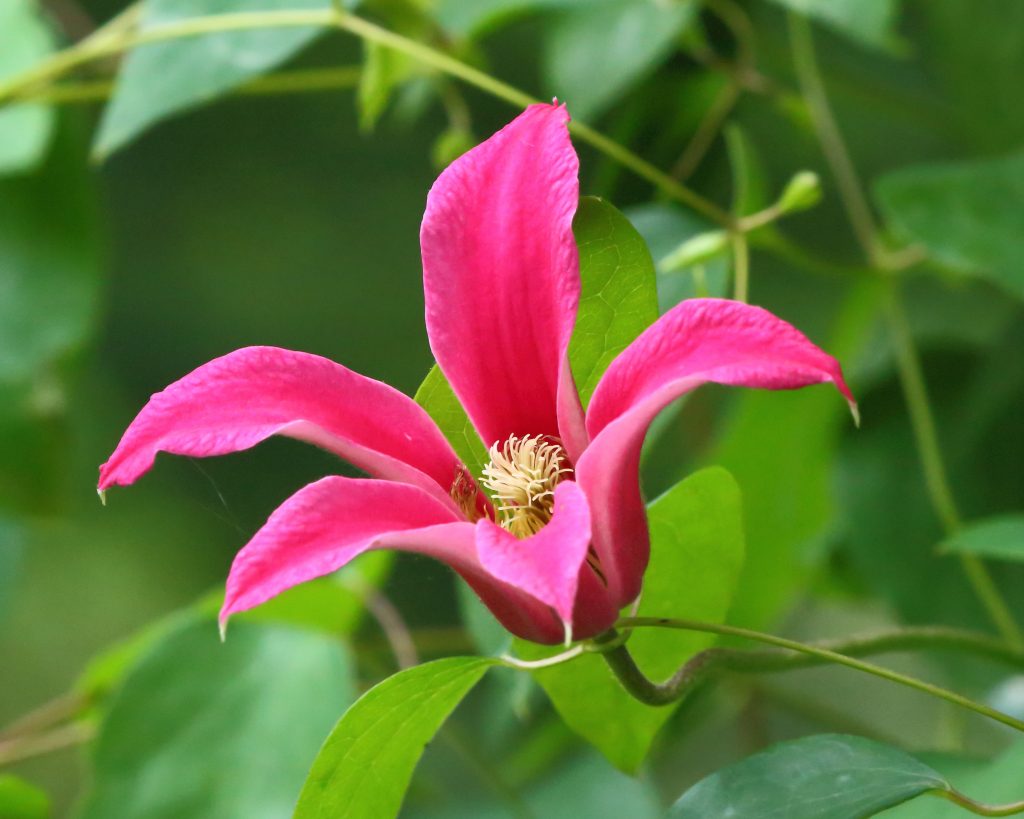
Clematis princess diana photo and description
Description of the variety
This is a fast-growing herbaceous vine (clematis), the shoots of which reach 2-2.5 m in length. The leaves are dark green, small, rounded. They are located at a distance of 4-5 cm from each other. They have long petioles, with the help of which they cling to any support - a net, a wall, trees and bushes.
The main pride and decoration of the Diana variety is its unusual tulip-shaped flowers. The petals are long, up to 8 cm, pointed, raised and closed together. The color of the buds is pink-red, burgundy-brown anthers are located inside, but they are almost invisible.
Clematis smells delicious. The aroma is especially enhanced in the evening and early morning.
The flowering period is not too long - from June to August. It does not bloom again even in southern latitudes, but the bush still looks attractive. Until the very frost, it is decorated with decorative seed fruits - bright berries. However, the seeds do not have time to ripen and are not suitable as planting material.
Landing features
The variety has a high resistance to frost. With good shelter, it can withstand winters down to -45 ° C.
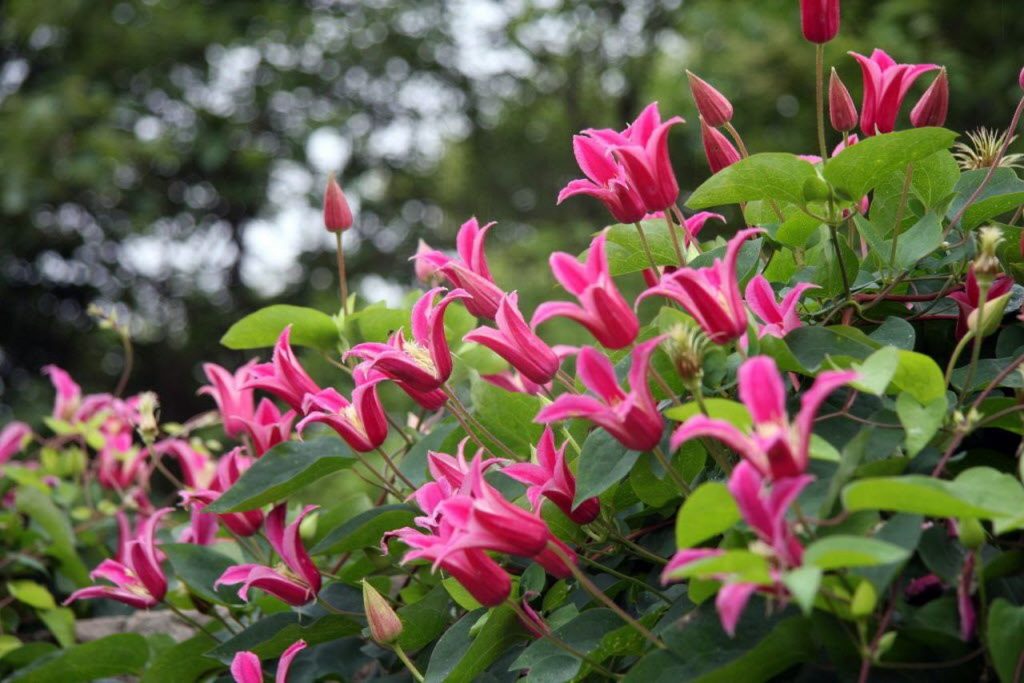
Clematis princess diana reviews
Clematis is planted both in autumn and spring. In the second case, the seedling will have more time to take root, but it will bloom a year later.
Autumn planting is preferable, but only if the plant is healthy and has a good root system.
Seat selection
Clematis loves lit areas with occasional shading. For example, he will be comfortable under the shade of a large fruit tree or by the south or southeast wall of the house. The hybrid is afraid of strong winds, the bush must be protected from them, especially the first 2-3 years.
In the constant open sun, the roots will dry out and overheat. This is unacceptable, the Princess Diana variety is prone to disease due to lack of moisture, and its delicate foliage can wither in the bright sun, and the buds crumble or not set at all.
Preparation of planting material
Saplings bought in a store or sent by mail must be carefully examined.
Cuttings with dormant buds are usually sold in special bags with peat or earthen clod. They should be placed at the bottom of the refrigerator and kept there until new shoots begin to grow. From this moment, the seedling is ready for planting in the ground.
Cuttings with branches and leaves are purchased 10-14 days before planting. They are stored in a cool place, and then planted in the ground.
Immediately after the purchase, it is impossible to determine the plant to a new place in the garden - it is transferred to quarantine.During this time, it will become clear whether it is healthy.
A healthy seedling is bright green, with clean bark without plaque, growths and spots. Leaves of uniform color, smooth, without signs of insect activity. The root system consists of at least three roots, they are dense, even, with a white core. Only such seedlings are planted in open ground.
Landing technology
A hole for the bushes is prepared in advance. The Princess Diana hybrid has relatively developed roots, so the size of the pit is about 70x70. A multilayer drainage must be laid at the bottom, especially if groundwater passes under the bush.
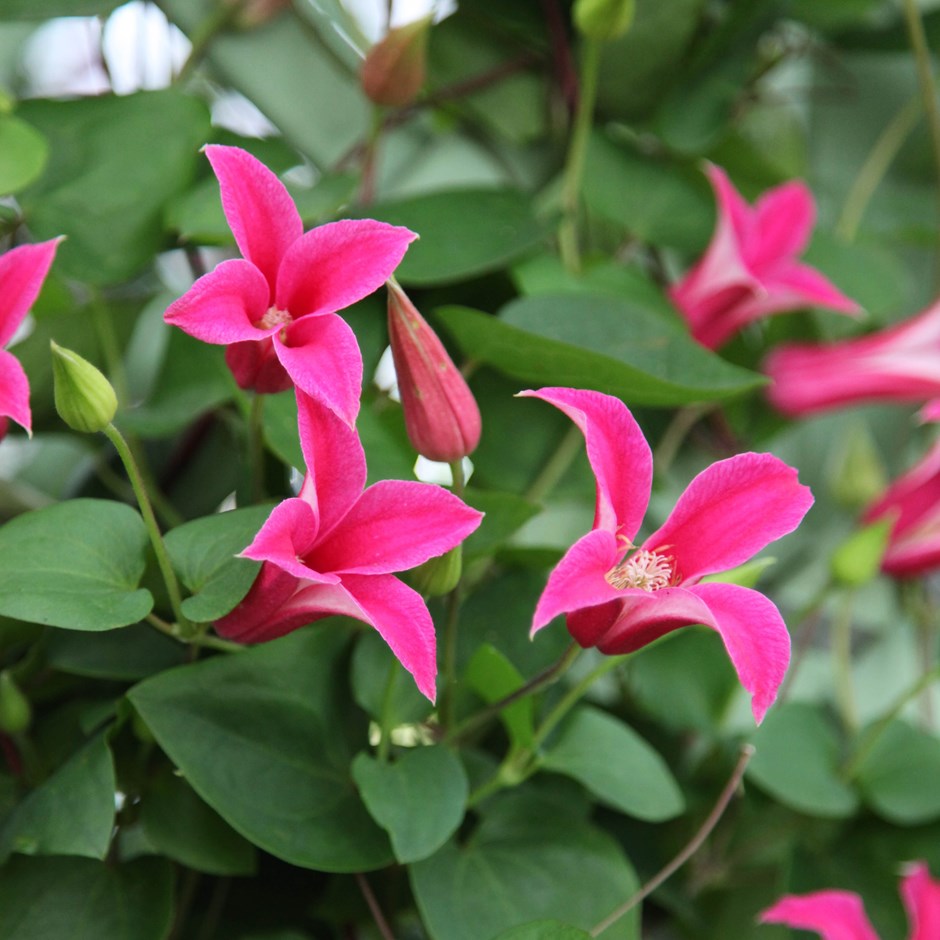
Clematis texas princess diana
In this case, there is a high risk of rotting the roots of the plant, therefore drainage consists of:
- stones;
- large expanded clay;
- chipped clay shards;
- river sand.
On top of the drainage, nutritious soil is laid out from leafy earth, humus, compost, peat. If the acidity is high, it is reduced with dolomite flour and ash. Ideally, the cultivar prefers neutral soil.
The seedling is placed on the ground. Spread the roots and sprinkle on top. Planting depth depends on the season.
- In the spring, the seedling is buried more - by 20-25 cm. This will prevent the roots from the sun and rapid evaporation of moisture.
- In winter, it is buried in 15 cm, but also so that the root collar is underground.
Care
Hybrid Princess Diana is unpretentious, tolerates cold well, but is not resistant to disease. Therefore, you need to care for the plant carefully, carefully monitoring the slightest changes.
Problems with the root system are not immediately visible, and the consequences can be dire.
Watering
The variety loves moisture, responds well to frequent watering, especially in the summer heat. A young seedling in the first year should be watered every 3-4 days.
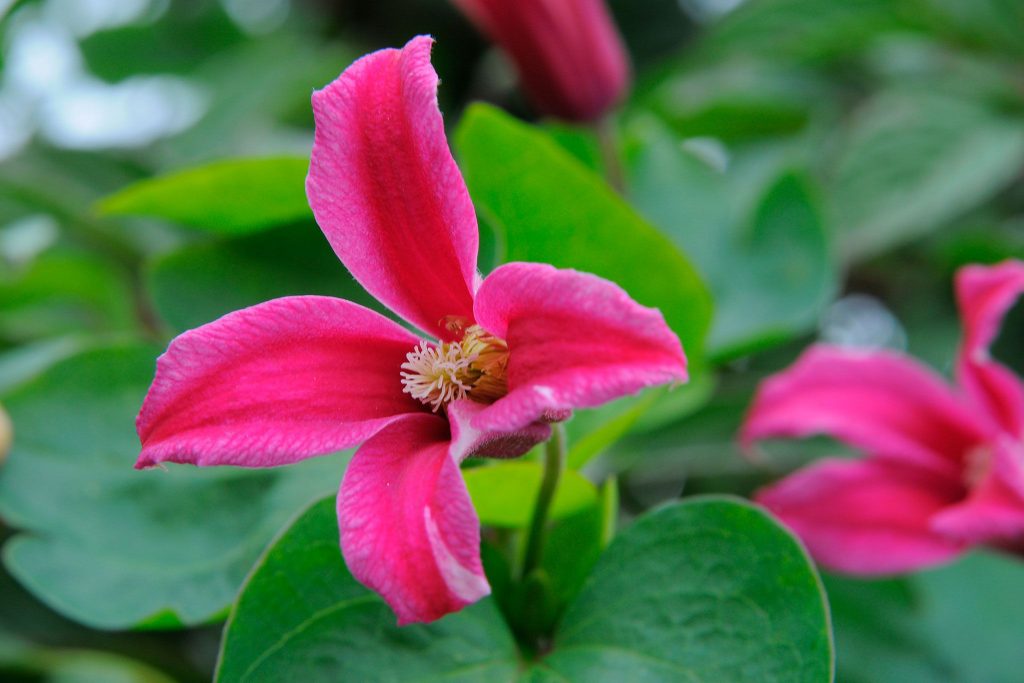
Clematis diana
If the summer is rainy, then it is important not to overdo it with watering. However, moisture during this period is very important for the regrowth of small roots, without which the plant will not be able to feed.
An adult bush is watered less often:
- in summer - once every 5-6 days;
- in the fall - once every 10-14 days.
It is better to take water standing or rainwater. In the summer, on the site, it is easy to collect it in a barrel, placing it under a roof. Some gardeners water young bushes with warm water, but this is not necessary. On the contrary, the seedlings must be hardened, then they will more easily endure the winter.
Top dressing
The Princess Diana variety is demanding on the nutrient content of the soil and regular feeding. However, it is not worth fertilizing the seedling for the first year.
They begin to make top dressing in early spring, before bud break. At this time, the plant needs nitrogen. Most of this element is found in urea, carbamide and nitrate. They are sold both separately and as part of mineral complexes. One of them is UAN - a nutritious urea-ammonia mixture.
Before flowering, clematis needs phosphorus and potassium. Budding takes a lot of energy, so the introduction of additional fertilizing during this period is necessary.
The main fertilizers for lush and long flowering are:
- Superphosphate;
- Sulfate or potassium chloride;
- Ammofosk or nitroammofosk;
- Potassium sulfate.
All these complexes are easily absorbed by the roots, give strength before flowering, and increase immunity. The main thing is to apply strictly according to the dosage indicated in the instructions.
Ideally, you need to know exactly the acidity and composition of the soil in order to determine which substances the culture needs more.
In the fall, rotted manure is laid under the clematis bush. It is better if it is dry, mixed with straw, hay or sawdust. Such dressing will not only enrich the soil, but also improve its structure. The earth will become looser, softer, more breathable. Organic matter promotes the development of beneficial bacteria in the soil, helps clematis to assimilate useful trace elements.
The variety is also fertilized with home remedies. For example, tea leaves or coffee cake. If you dig them into the topsoil, you get an excellent mulch. Potato broth, which contains a lot of starch, is useful.Ordinary sugar is also suitable for plant feeding - it is simply scattered under a bush or poured over with sweet water.
It is very good to fertilize clematis with herbal infusion, especially nettle leaven. It is prepared simply - nettles are cut into a barrel, poured with water and left to sour under the lid for a month. When the infusion begins to foam, water the plant with it. Sometimes yeast is added - they are also good for flowers.
Loosening and mulching
The roots grow parallel to the surface, shallow, and are in great need of constant access to air.
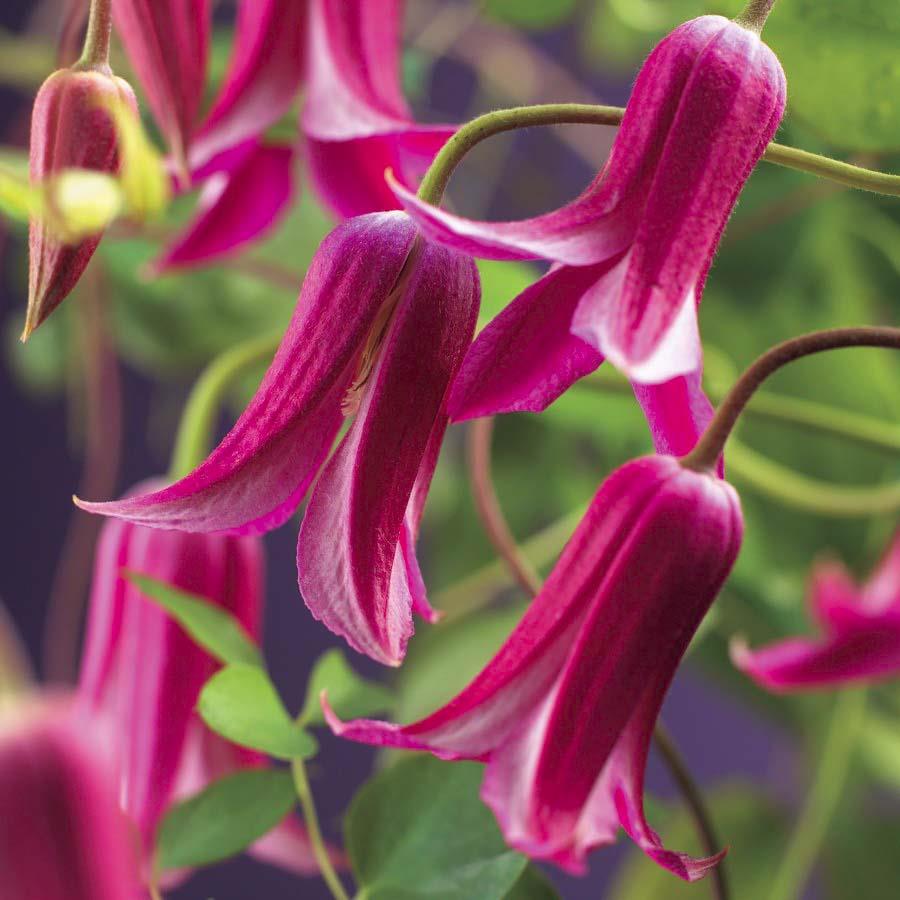
Princess diana clematis
It is imperative to loosen the soil under the bush - so it will be healthier and stronger, and flowering - longer. The main thing is to do it carefully so as not to damage the root system.
Mulch the soil in the near-trunk circle to lighten the soil, as well as to protect the roots from overheating and drying out. Most often, fresh hay or straw is used as mulch. Dry peat is also good.
Sawdust is allowed only in spring and summer, they cannot be laid under a bush for wintering. When wet, they are strongly compressed, become dense and heavy, and freeze in winter.
Low annuals are often used as mulch. They are simply planted under a bush and left that way until autumn. Flowers will prevent other weeds from growing, protect the roots of clematis, and also prevent pests from attacking it. For example, marigolds and calendula perfectly repel various insects that harm clematis.
Pruning
The princess Diana variety belongs to the III pruning group - the most convenient for beginner florists. In autumn, the shoots are cut out completely, leaving small stumps with 3-4 buds above the ground. Of these, new vines will appear later in the spring.
Some lovers of clematis do not cut them completely for the winter, leaving a few shoots for the winter. This makes no sense - this variety produces buds only on fresh, young shoots.
Cut the bush just before the frost, when the bush has completely thrown off the foliage. It is imperative to treat the cut sites with a fungicide (Fitosporin) and cover with activated carbon.
The cut shoots are used as a "pillow" to cover the plant for the winter. Beforehand, they should be dried a little.
Shelter for the winter
Princess Diana is a frost-resistant hybrid. In southern latitudes, it is not even always sheltered, and the plant winters well under the snow.
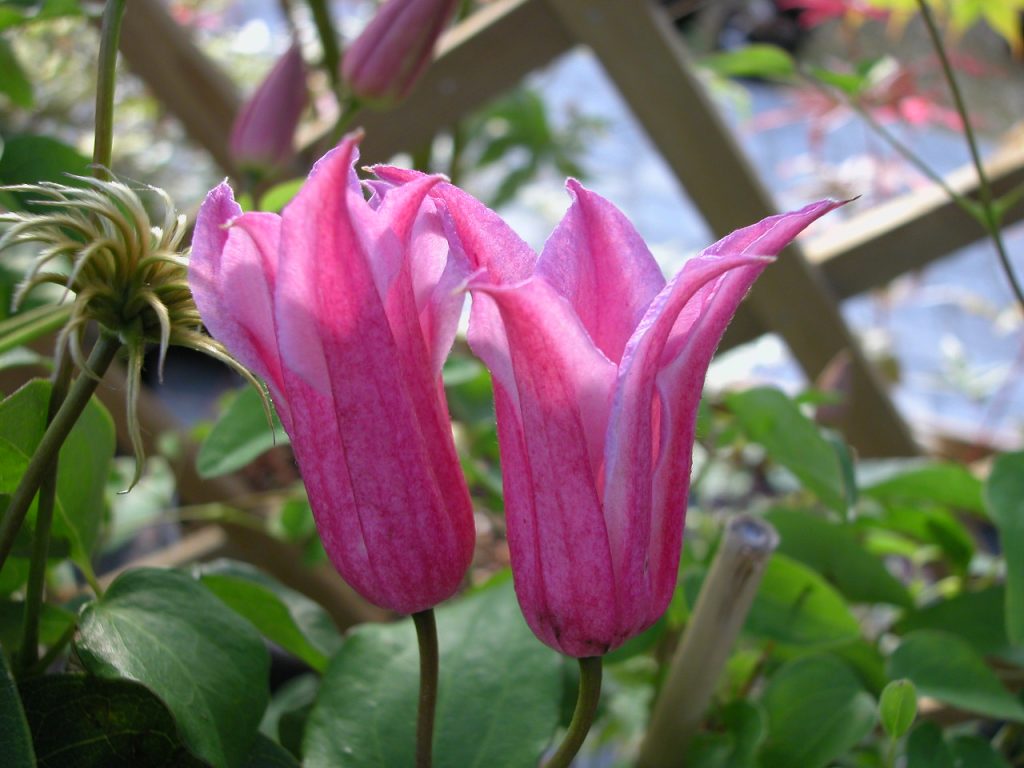
Clematis princess Diana
In the middle lane or more northern areas, the bush needs shelter. There are several ways to organize it:
- After trimming, the stump sticking out of the ground is covered with spruce branches, a nonwoven material is placed on top and covered with a film. Bricks or stones are laid out along the edges so that they are not scattered by the wind.
- The cut clematis is covered with dry manure, a layer of dry foliage is thrown over it and covered with sponbond.
- The planting site of the bush is simply covered with dry straw and on top with a sheet of slate.
Important! In the spring, you should not be late with removing the shelter from clematis. Its roots can rot from excess heat and moisture. This is especially true if a film was draped over.
Reproduction
The hybrid is propagated in several ways. Each of them is simple and allows you to preserve all the varietal properties of the mother plant in the new plant.
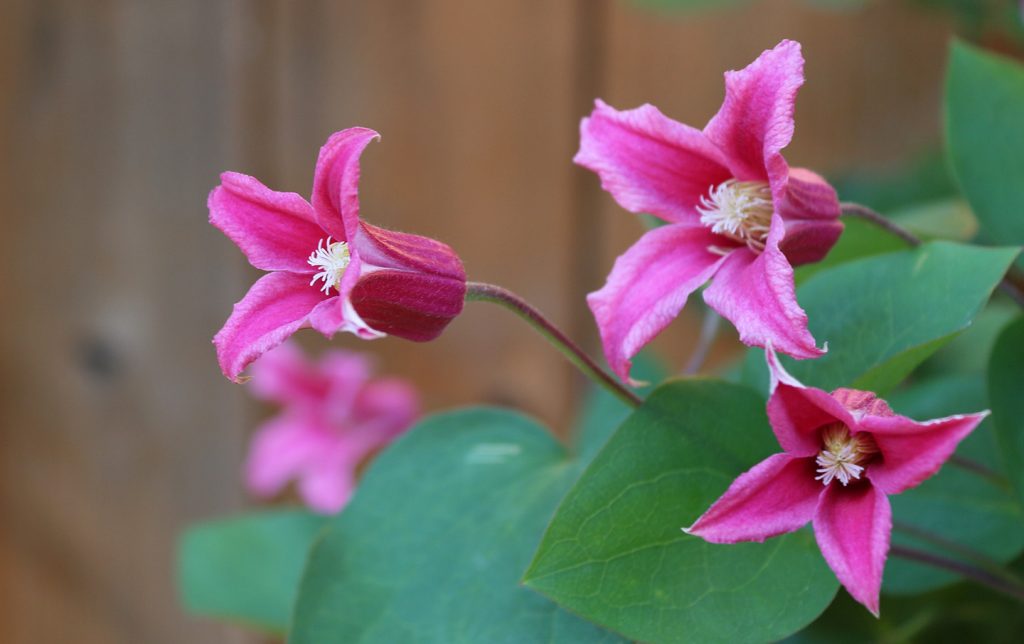
Clematis diana photo
It is better to start the breeding procedure for clematis in the spring, when the winter sleep is over, and the active growth of the bush has begun.
Layers
The extreme shoots are bent to the ground and added dropwise so that the top remains on the surface. To be sure, fix the branch with a stone or brick. Water the ground periodically so that roots will form sooner. Some people build a greenhouse over the shoot, but this is not necessary.
The cuttings take root in about a month. Success depends on air temperature, irrigation regime, soil type and the age of the bush itself. Some old clematis grow roots on their own. Young shoots begin to grow near the main bush. They are also deposited, as well as forcibly rooted layers.
Cuttings
The most common breeding method for clematis. Cuttings are cut in the spring, when young vines are just beginning to grow.
2-3 buds are enough for rooting. It is possible to do this in water, but it is better to place it in the ground. So the plant immediately adapts to the growing conditions in the soil without the risk of dying during transplantation.
In light soil, the stalk is placed at an angle - so it will be easier for the roots to grow. At a temperature of +27 ° C and with frequent watering, the cutting will take root quickly - in 2-3 weeks. Then new leaves will begin to grow. Already in the fall, the young plant is transferred to the garden to a permanent place, or you can wait until next year.
By dividing the bush
This procedure is used for adults and old clematis bushes - over 8 years old. They are very thickened, bloom poorly and need to be planted.
The bush is dug up, cut into separate parts with a knife or a shovel. One can make up to 6 small plants.
After separation, the main trunk is returned to its old place, having previously renewed the soil. The rest are planted separately.
Diseases and pests
The Princess Diana hybrid is often prone to disease, especially all kinds of rot. They develop with an excess of moisture and a lack of lighting. For prevention, the plant should be watered in the spring with a solution of Fundazol. The Azocene is also good in this regard.
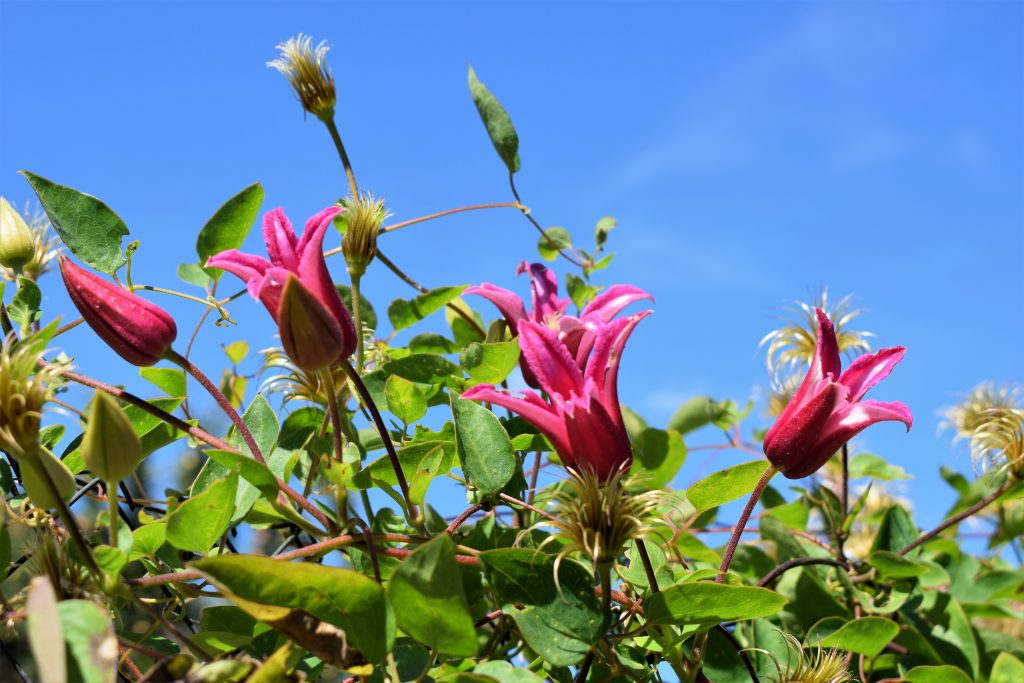
Clematis pruning group princess diana
Rust can be easily cured by spraying with copper-containing preparations. Copper oxychloride or Bordeaux liquid is the best way to fight fungus. Copper sulfate will help get rid of ascotichosis.
The most dangerous pests are root nematodes. It is impossible to save the bush from them if they have already multiplied in the roots. The plant must be disposed of. But it is possible to prevent the appearance of pests by carefully preparing and disinfecting the ground when planting.
Sometimes the shoots eat the caterpillars. To cope with them is simple with the help of the drugs Lepidocid and Biotlin. Every morning you need to inspect the plant and collect insects by hand. The same goes for slugs. If there are too many of them, you can sprinkle the ground around the bush with crushed brick or shells. Slugs will not be able to crawl onto the bush.
Use in landscape design
Clematis varieties Princess Diana are used to decorate gazebos, build high arches, on both sides of which these beautiful flowers are planted. They also cope with the decor of the walls, quickly curling them with a green and then a floral carpet.
You can combine clematis with other curly flowers. For example, with roses, grapes, hydrangea. By picking up different varieties of clematis, and planting them side by side, you can achieve continuous flowering of these beautiful crops from early spring to the first frost.
Testimonials
Gardeners generally respond positively to the Princess Diana variety. Everyone likes the unusual flowering of the hybrid, its resistance to frost. A simple cropping also adds a "plus" to the reviews.
The main disadvantage is the instability of clematis to wilting and rot. However, you can prevent them by carefully observing the watering regime and locating the plant in the right place.
With a good climate and care, the bush can grow and bloom luxuriantly for a very long time - several decades.

